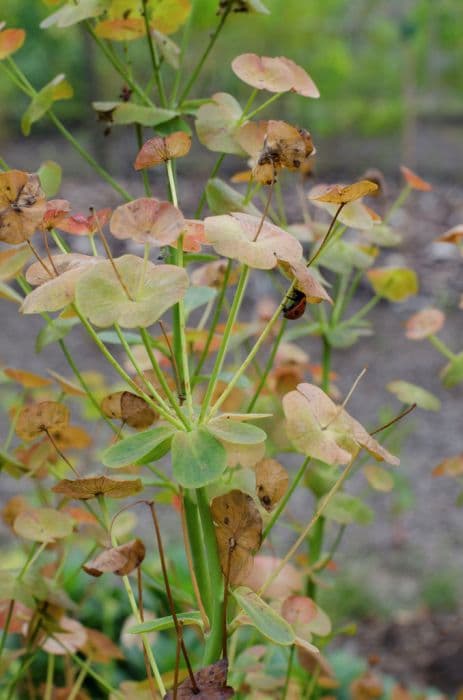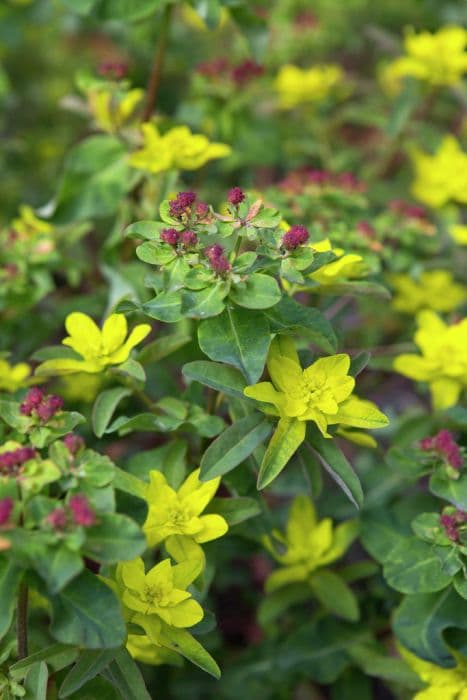Sea Spurge Euphorbia paralias

ABOUT
Euphorbia paralias, commonly known as sea spurge, is a herbaceous plant with a green to gray-green appearance. This perennial bears narrow leaves that are arranged alternately along its stems. The leaves of the sea spurge are glossy and have a linear shape, contributing to its slender and elongated look. Stems may exhibit a slightly woody base as the plant matures. Flowering occurs in the sea spurge, producing inconspicuous, small flowers. These flowers are uniquely structured, featuring a central female flower surrounded by male flowers, all enclosed within a cup-like structure called a cyathium, which is characteristic of all plants in this genus. The cyathia may be found clustered at the terminal ends of the branches. The plant develops small, rounded, three-lobed seed capsules upon the conclusion of the flowering period. These seed capsules contain seeds that are often capable of being dispersed by the sea since sea spurge usually grows in sandy coastal habitats. The overall coloration and structure of the sea spurge provide it with a certain camouflage, allowing it to blend into its natural surroundings, while its tactile features reflect its adaptation to seaside environments.
About this plant
 Names
NamesFamily
Euphorbiaceae.
Synonyms
Sea Spurge, European Seaside Spurge, Sand Spurge, Seaside Spurge, Beach Spurge.
Common names
Euphorbia paralias.
 Characteristics
CharacteristicsLife cycle
Perennials
Foliage type
Evergreen
Color of leaves
Green
Flower color
Yellow
Height
1-2 feet (0.3-0.6 meters)
Spread
1-2 feet (0.3-0.6 meters)
Plant type
Shrub
Hardiness zones
9
Native area
Mediterranean
Benefits
 General Benefits
General Benefits- Coastal stabilization: Euphorbia paralias, commonly known as sea spurge, has extensive root systems that help bind the sand, contributing to dune stabilization and coastal protection.
- Erosion control: By helping to stabilize sand dunes, sea spurge reduces sand erosion caused by wind and water.
- Habitat for wildlife: Sea spurge provides habitat and protection for various species of insects and other wildlife that live in coastal dune ecosystems.
- Adaptation to saline environments: Sea spurge is highly adapted to saline environments, making it useful for vegetation in areas where many other plants cannot survive due to high salt concentrations.
 Medical Properties
Medical Properties- This plant is not used for medical purposes.
 Air-purifying Qualities
Air-purifying QualitiesThis plant is not specifically known for air purifying qualities.
 Other Uses
Other Uses- Euphorbia paralias, commonly known as Sea Spurge, can be used in sand dune stabilization and coastal landscaping due to its hardy nature and ability to thrive in sandy soils.
- The latex of Sea Spurge may serve as a natural adhesive or a waterproofing agent because of its sticky and durable properties.
- The plant has been used in the past for making fish poison in some cultures due to the toxic components found in its sap.
- Sea Spurge can be considered as an ornamental plant in gardens designed to mimic coastal ecosystems or for xeriscaping due to its tolerance to drought and salinity.
- Its dense root system may be harnessed for erosion control on slopes and embankments where soil retention is important.
- The fibers from Sea Spurge have potential use in crafting and textiles, although this is not a widespread application.
- In some regions, the dried plants are used in making rudimentary brooms or brushes because of their stiff stems and leaves.
- Folk traditions in some cultures could potentially use the vivid green of Sea Spurge as a natural dye for fabric or art materials, although care must be taken due to toxicity.
- The plant's ability to survive in high salinity may be studied for bioengineering purposes, potentially offering insights into salt tolerance for agricultural crops.
- Some parts of the plant might be used as a feedstock for biomass or biofuel production, although its toxicity would need to be mitigated or removed during processing.
Interesting Facts
 Feng Shui
Feng ShuiThe Sea Spurge is not used in Feng Shui practice.
 Zodiac Sign Compitability
Zodiac Sign CompitabilityThe Sea Spurge is not used in astrology practice.
 Plant Symbolism
Plant Symbolism- Resilience: Euphorbia paralias, also known as Sea Spurge, often grows in sandy, coastal areas, symbolizing its ability to thrive in challenging conditions and representing the human capacity for resilience in the face of adversity.
- Adaptability: Sea Spurge's tolerance to salt and wind highlights its adaptability, reflecting the necessity to adjust to varying environments or situations in one's life.
- Purification: Historically, the Euphorbia genus has been associated with purifying qualities, which could translate to the Sea Spurge symbolizing a purging of negative thoughts or influences.
- Protection: The toxic sap of Sea Spurge serves as a defense mechanism against herbivores, making it a symbol of protection and self-defense.
- Caution: Due to its irritating sap, Sea Spurge also symbolizes caution, reminding us to be aware of hidden dangers or to approach certain situations with care.
 Water
WaterThe Sea Spurge should be watered thoroughly, allowing the top inch of soil to dry out between watering sessions. In general, watering this succulent once every week to two weeks should suffice, but this can vary depending on environmental factors like temperature and humidity. It's better to underwater than overwater, as Sea Spurge is drought-tolerant. Typically, for an average-sized pot, using approximately 16 to 32 ounces of water when the soil is dry should keep the plant healthy without risking overwatering. Adjust the frequency based on the plant's response and the current season, reducing watering in the cooler months.
 Light
LightSea Spurge thrives best in full sunlight conditions, making it ideal for spots that receive direct, unfiltered sunlight for most of the day. Although this plant can tolerate partial shade, its growth and health are optimal when placed in an area with abundant light. If you're growing Sea Spurge indoors, place it near south or west-facing windows where it will receive ample sunlight, or supplement with grow lights if necessary.
 Temperature
TemperatureSea Spurge grows best in environments with temperatures ranging from 60°F to 75°F, which are ideal for its growth and development. It can tolerate minimum temperatures down to about 30°F but should be protected from frost to prevent damage. Maximum temperatures for healthy growth should not exceed 90°F. Ensure that the Sea Spurge is positioned in a location where temperature fluctuations are minimal, as sudden changes can stress the plant.
 Pruning
PruningPrune Sea Spurge to remove any damaged or diseased parts and to shape the plant as desired. Pruning is best done in the spring when the plant is entering its active growth phase. This plant does not require heavy pruning; a light trimming to maintain its size and remove any unwanted growth is generally sufficient. Always use gloves and protective eyewear when pruning Sea Spurge, as its sap can be irritating to skin and eyes.
 Cleaning
CleaningAs needed
 Soil
SoilSea Spurge (Euphorbia paralias) thrives in sandy, well-draining soil with a slightly acidic to neutral pH between 6.0 and 7.5. A mix can be made using two parts sand or grit, one part garden soil, and one part compost or peat. This combination ensures proper drainage and mimics the plant’s natural coastal habitat.
 Repotting
RepottingSea Spurge (Euphorbia paralias) is adapted to nutrient-poor conditions and does not require frequent repotting; it should be repotted every two to three years or when it has clearly outgrown its current container.
 Humidity & Misting
Humidity & MistingSea Spurge (Euphorbia paralias) is tolerant of a wide range of humidity levels; however, it prefers drier conditions typical of its natural coastal and sandy habitats.
 Suitable locations
Suitable locationsIndoor
Place Sea Spurge in a sunny spot with good airflow.
Outdoor
Plant in sunny area, well-draining soil, protect from cold.
Hardiness zone
8-10 USDA
 Life cycle
Life cycleEuphorbia paralias, commonly known as sea spurge, begins its life cycle as a seed that germinates when conditions are favorable, typically in sandy soils and coastal environments where it's native. After germination, the seedling emerges and develops a root system and foliage, growing into a hardy, herbaceous perennial that can tolerate harsh seaside conditions. As the plant matures, it forms a sturdy stem and produces small, greenish flowers enclosed within specialized structures called cyathia, unique to the Euphorbiaceae family. Following pollination, which is often facilitated by wind or insects, the flowers develop into fruit, specifically a three-lobed capsule that eventually dries and splits open to disperse seeds. The seeds are then spread to new locations by wind, water, or animal activity, allowing the plant to colonize other suitable areas along the coast. This process can repeat annually, with sea spurge plants often forming dense stands that dominate their local habitat.
 Propogation
PropogationPropogation time
Spring-Early Summer
The most popular method of propagation for Sea Spurge (Euphorbia paralias) is through its seeds. This plant typically disperses its seeds in late summer or fall, which is the ideal time to collect them for propagation purposes. To propagate Sea Spurge from seed, one should start by sowing the seeds in well-draining soil at a shallow depth, since light aids germination. Covering the soil with a thin layer, no more than a quarter of an inch (about 6 millimeters), will suffice. The soil should be kept moist but not waterlogged, and the seeds usually require a warm environment to germinate effectively. Once the seedlings have grown strong enough and the risk of frost has passed, they can be transplanted to their final growing position outdoors. It's important to handle the seedlings with care, as Euphorbia sap can be an irritant.


![Spurge [Silver Swan]](/_next/image?url=https%3A%2F%2Fplants-admin.emdemapps.com%2Fimages%2Fplants%2F%2Fimages%2F604b573f6c8f6.png&w=640&q=75)






